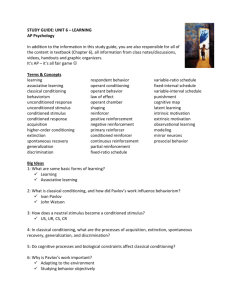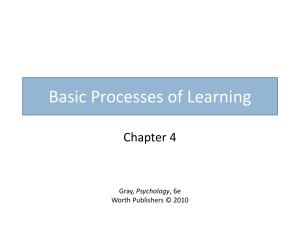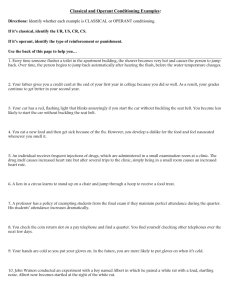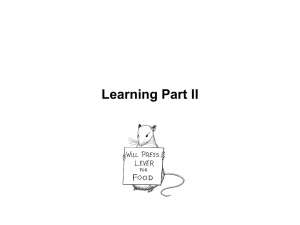Lap 3 - Mr. Bambenek
advertisement
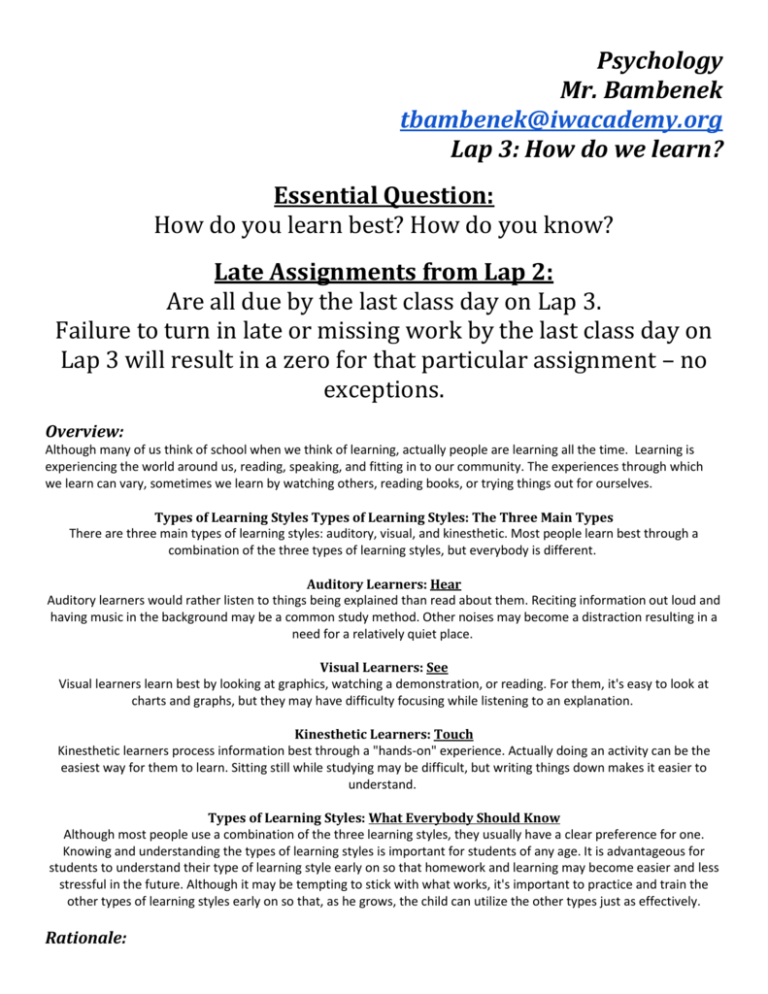
Psychology Mr. Bambenek tbambenek@iwacademy.org Lap 3: How do we learn? Essential Question: How do you learn best? How do you know? Late Assignments from Lap 2: Are all due by the last class day on Lap 3. Failure to turn in late or missing work by the last class day on Lap 3 will result in a zero for that particular assignment – no exceptions. Overview: Although many of us think of school when we think of learning, actually people are learning all the time. Learning is experiencing the world around us, reading, speaking, and fitting in to our community. The experiences through which we learn can vary, sometimes we learn by watching others, reading books, or trying things out for ourselves. Types of Learning Styles Types of Learning Styles: The Three Main Types There are three main types of learning styles: auditory, visual, and kinesthetic. Most people learn best through a combination of the three types of learning styles, but everybody is different. Auditory Learners: Hear Auditory learners would rather listen to things being explained than read about them. Reciting information out loud and having music in the background may be a common study method. Other noises may become a distraction resulting in a need for a relatively quiet place. Visual Learners: See Visual learners learn best by looking at graphics, watching a demonstration, or reading. For them, it's easy to look at charts and graphs, but they may have difficulty focusing while listening to an explanation. Kinesthetic Learners: Touch Kinesthetic learners process information best through a "hands-on" experience. Actually doing an activity can be the easiest way for them to learn. Sitting still while studying may be difficult, but writing things down makes it easier to understand. Types of Learning Styles: What Everybody Should Know Although most people use a combination of the three learning styles, they usually have a clear preference for one. Knowing and understanding the types of learning styles is important for students of any age. It is advantageous for students to understand their type of learning style early on so that homework and learning may become easier and less stressful in the future. Although it may be tempting to stick with what works, it's important to practice and train the other types of learning styles early on so that, as he grows, the child can utilize the other types just as effectively. Rationale: In this LAP, students will examine various learning theories, including classical conditioning, operant conditioning, social learning, and cognitive learning. Students will explore each theory and make applications to everyday life. Learning Goals: 1. 2. 3. 4. Describe the principles and techniques of classical and operant conditioning and social learning. Explain the concepts of memory and information processing. Identify the basic elements of language Explain reasons for the physiological and psychological factors associated with motivation and emotion. Lap 3 Summative Assessment: Essential Question: How do you learn best? How do you know? Your Lap 3 test will follow the same format as past tests. This test will also add a short answer section as well. Your short answer question directly relates to the Essential Question so there should be no reason why you do not do extremely well on that part. If you are testing with Mrs. Stokes please notify me prior to the testing date. Test will be taken in class on K – Day 10/30 Enrichment Movies that involve various types of psychology. *You may only choose one option Watch one of the movies below, hand write – not type – a summary of the movie on loose leaf paper. Only one side is needed; however if you write large you may need to use the reverse side. Your summary is due on the last day of the Lap. 1. Finding Forester 2000 – Sean Connery and Jamal Wallace 2. The Miracle Worker 1962 – Anne Bancroft and Patty Duke Calendar of Events Day 1 1. Due at class time – Nothing at this time. K – Day 10/30 2. What we are doing today – Go through the Lap. Discussion of how we learn. Pre – Test. Recall a situation in which you taught another person a skill or how to do a task. Write a brief account about it. Make sure to include a description of how reinforcement, punishment, or modeling was part of your teaching strategy. D – Day 10/6 3. Assignment for next time – Review Chapter 9, section 1: Classical Conditioning and section 2: Operant Conditioning in your Psych text. Watch the video on the Weebly site titled, “How to train a brain.” When you are finished reviewing the chapters and watching the video in a 5 – 6 well constructed sentences explain the major differences between Classical and Operant Conditioning. Be prepared to discuss. Please bring a hand written or printed out copy to class for me. Day 2 1. Due at class time – Your printed out copy of comparing Classical and Operant Conditioning. 2. What we are doing today – Explanation of Classical Conditioning. Explanation over Operant Conditioning. We will watch the video over “Little Albert” on the Weebly site. Examples of Classical or Operant Conditioning in your life today? Using principles of operant conditioning, design a plan to teach a puppy a new trick. E – Day 10/7 3. Assignment for next time – Review Chapter 9, section 3: Social Learning in your Psych text. Also, watch the video on the Weebly site under the “Social Learning” heading. After reviewing the section and watching the video answer the following question in 5 – 6 well constructed and grammatically correct sentences. What principles of modeling should parents consider when rewarding and punishing their children? Provide reasons for your answer. Please bring a hand written or printed out copy to class for me. Day 3 1. Due at class time – Your handwritten or typed response to the Day 2 question. Be ready to discuss. G – Day 2. What we are doing today – Learned Helplessness video on the Weebly site. Discussion over Learned Helplessness and why it happens. How do we combat this phenomenon in our lives today? What can we do, or are we stuck? Token Economics in Mr. Huber’s class. Would they work? What would they be? 10/9 3. Assignment for next time – On page 265 in your text the authors outline two options for improving study habits in people, SQ4R method and the PQ4R method. In your notebook please make a two columned chart weighing pros and cons to each method for yourself. Decided which model you agree with. Once you have created the chart in your notebook explain in 5 – 6 well constructed sentences why the method you chose is better than the other method. This part you will turn in. Be prepared to discuss your findings in class and be prepared to defend your position. Please bring a hand written or printed out copy to class for me. Day 4 1. Due at class time – Your typed or handwritten response to the question. 2. What we are doing today – Today we are going to be taking a series of memory tests and see how we do. We also will discuss the process of taking in and storing information (encoding, storage, and retrieval). We will also be creating our own memory exercise that you will be playing/testing on each other. B – Day 10/20 3. Assignment for next time – Memories, both painful and pleasant, are a common theme in music. Find two examples of songs, one that brings back a pleasant memory and the other a more difficult memory. If you have a device have the song queued up and ready to play on class day 5 so we can look at selections from everyone. In 5 – 6 well constructed sentences focus on one song, it doesn’t matter which one, and talk about why the memory is tied to the song. Bring your typed or hand written response to class and be ready to share. Day 5 1. Due at class time – Have your songs ready to share in small groups. Have your responses ready to turn in. 2. What we are doing today – We will look at memory again, this time short-term memory (maintenance rehearsal, chunking, the primacy-recency effect, and working memory) and long-term memory (semantic, episodic, declarative, and procedural). D – Day 10/22 3. Assignment for next time – Brainstorm examples of the four main types of long-term memory: semantic, episodic, declarative, and procedural. Find existing magazine pictures or draw pictures of your own that illustrate the type of longterm memory. Bring the photos to class and be ready to explain. Day 6 1. Due at class time – Photos due. Be ready to explain ALL four. E – Day 2. What we are doing today – Today we will be discussing your four images that you brought in. Be ready to share with the class the types of memories that they represent. We will also be looking at how we retrieve information such as recognition, recall, relearning, forgetting, and how to improve memory through elaborative rehearsal and mnemonic devices. 10/23 3. Assignment for next time – Watch the video on the Weebly site under the “Cognition” heading. Bring an object in from home that describes you or your family. This can be something simple or complex. Please, do not try and convince me and the class that a phone represents you or your class ring or anything that you have in your book bag the mods before and realize that you forgot what you were supposed to be doing. Day 7 1. Due at class time – Discussion over video and bring your object to class. 2. What we are doing today – Today we will play charades! After our game of charades we will be looking at the objects we brought in and decide if they are an image, symbol, concept, prototype, or rule. We will also talk about what happens when you cannot solve a problem and need to change your approach. G– Day 10/27 3. Assignment for next time – Read “Problem Solving” starting at the bottom of page 297 in your text. In 5 – 6 well constructed sentences write about a problem you have had in the past. Please be thorough in your explanation of the problem. If the problem cannot be described in 5 – 6 well constructed sentences then think of another problem. After you are finished describing the problem take some time and talk about first why the problem was an obstacle and how you overcame the problem. Specifically, what strategies did you use to figure out the solution to the problem? Bring your typed or hand written response to class and be ready to share. Day 8 1. Due at class time – Your problem and analysis of how you found a solution to the problem. 2. What we are doing today – All things problem solving related. We will talk about how to problem solve, obstacles to problem solving, and solvable problems in your life today. 3. Assignment for next time – Prepare for you test. Up next…Personality Theories J – Day 10/29

